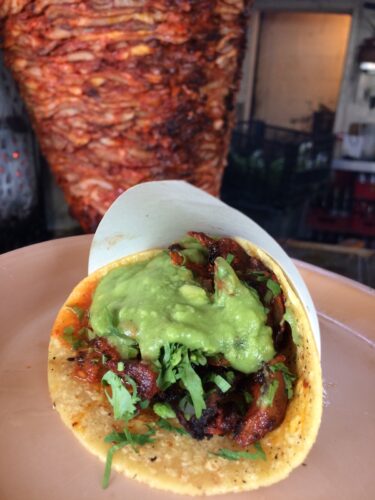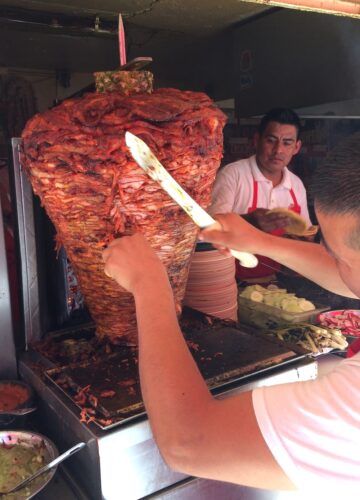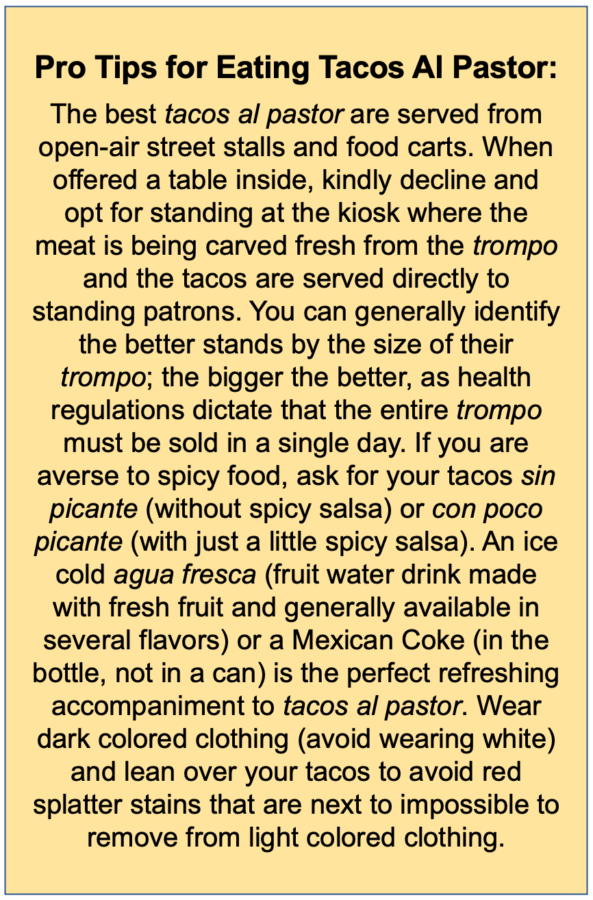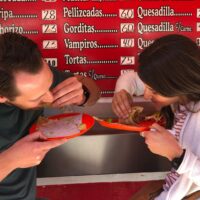Mexico’s Most Popular Street Tacos Borrow from Lebanese Heritage Cuisine

By Chris Mejia
Thin layers of marinated pork stacked high onto a vertical rotisserie spit and slow roasted until the outer layers become caramelized, then carved right from the turning spit into warm corn tortillas, create tacos al pastor, Mexico’s most ubiquitous street tacos. Despite their modern-day omnipresence throughout Mexico, especially in Mexico City where the gigantic rotating crimson stained trompos (spinning tops) can be easily spotted on most street corners, tacos al pastor (also known as tacos de adobada or tacos de trompo) are a relative newcomer to Mexican gastronomy.
To prepare tacos al pastor, thinly sliced cuts of pork shoulder are marinated overnight in a combination of spices, then carefully stacked onto a vertical rotisserie spit, and slowly cooked with charcoal or gas flame. Typical components of the adobo (marinade) include guajillo chile, achiote (annatto) paste, garlic, cumin, oregano, coriander, black peppercorn, cinnamon, cloves, bay leaf, vinegar, and orange or pineapple juice. The caramelized outer layer of meat is sliced thin off the spit with a large knife into small corn tortillas and served with a slice of fresh avocado, chopped onions, cilantro, salsa/picante, and a quintessential squeeze of lime. As a special treat, chunks of grilled pineapple are sometimes served with tacos al pastor, adding a pleasantly sweet component to these iconic savory street tacos.
While prevalent throughout Mexico today and having evolved from an ancient Ottoman empire cooking technique, tacos al pastor only began its nascent Mexican evolution in the 1930s. It was then that a group of Lebanese immigrants settled in Puebla and introduced the region to one of their homeland’s most well-known dishes, shawarma. From the Turkish word çevirme, which means “turning,” Lebanese shawarma is minimally seasoned and spit roasted lamb served on pita bread (similar to the Turkish döner kebab or the Greek gyros). This Lebanese classic street food morphed into tacos árabes (Arabic tacos—roasted lamb meat shaved onto thick flour tortillas) in Mexico, before Mexican cooks adapted the traditional Lebanese rotisserie technique and began preparing thin ribbons of pork (instead of lamb) marinated in a paste of Mexican spices to be cooked on the vertical spits—the sweet, spicy, and smokey shaved pork derivation is typically served on warm corn tortillas (instead of pita bread or flour tortillas). This Mexican adaptation eventually became known as al pastor, which means “shepherd style”—the term owing its origin to Middle Eastern sheep herders.

The mostly Christian Lebanese migrants fled their ancestral homeland for the typical motives of migration: to avoid forced military conscription, to escape sectarian violence, and to find economic prosperity. Arriving in Mexico, they brought their traditional foods and cooking methods. By the late 1930s there were restaurants in Puebla that served traditional shawarma, and by the 1960s a kind of a Lebanese-Mexican fusion cuisine could be found. Tacos al pastor remained mostly a Puebloan regional dish until the late 1960s, when the Mexican-born offspring of Lebanese immigrants spread throughout Mexico, opening their own restaurants that married their Middle Eastern culinary heritage with classic Mexican gastronomy. Today in Puebla, where there still exists a large Lebanese-Mexican population, tacos árabes can still be found served in a thick flour tortilla called pan árabe (“Arabic bread”—a cross between a tortilla and pita bread). While it’s hard to find authentic tacos árabes outside of Puebla, tacos al pastor are easily found in just about every little town and big city throughout Mexico.

A few of my favorite tacos al pastor in Baja California:
- “Tacos El Franc” in Tijuana just outside of the Mercado Hidalgo (Tijuana’s central produce market) is a world-famous taco stand featured in numerous culinary television shows (only opens in the late afternoon and stays open into the evening; located just outside the main tourist district in an area considered generally safe; there is a small but often congested parking lot at the restaurant, and you’ll find convenient and relatively safe paid daytime parking inside the market; ask any market vendor for a parking discount voucher; beware that market parking closes at dusk—ask the exit booth parking attendant for an exact closing time to be sure)
- “Las Ahumaderas” in Tijuana, affectionately known as “taco alley” to gringos in the know, is a row of open-air street stall taco stands located in central Tijuana just off the busy Blvd. Agua Caliente away from the tourist area; the furthest stand from Blvd. Agua Caliente serves the best tacos al pastor (a local’s favorite, you won’t find many gringos here; considered generally safe during the day, foreigners should avoid this area past dusk; street parking only; be sure to tip the parking attendant a buck or two before you leave)
- “Tacos El Norteño” in Playas de Rosarito, in the center of the town’s tourist area on the East side of the main drag and across the street from the Festival Plaza Hotel; walking distance from the Rosarito Beach Hotel (open late on weekends, but go early to avoid drunk college kids)
- “Tacos El Paisano” in Playas de Rosarito, a block north of Tacos El Norteño on the same side of the street, also in the tourist area on the main drag and walking distance from the Festival Plaza Hotel or Rosarito Beach Hotel (open late on weekends, but go early to avoid drunk college kids)
- “El Trailero” in North Ensenada on the east side of Highway-1; as you are approaching town from the North heading South, you’ll need to make a U-turn after passing the restaurant and then immediately enter the frontage road on your right (this famous roadside truck stop taqueria features a variety of Baja’s best tacos, all excellent, so be sure to go hungry if you are going to sample more than tacos al pastor; street parking in front, or lot parking in the rear are free; generally considered a safe area)

Chris Mejia is an experienced culinary guide, food writer, and self-proclaimed “gastronomer” who has spent years exploring and curating the best of Baja California’s vibrant food scene. Follow Chris on Instagram and Facebook @MrStretchyPants.

Another fabulous issue, ladies! Thank you and stay well.
Sally Sherman
Boise, ID
My college room-mate was born in Tijuana and raised in San Ysidro before heading off to college in Southern California back in the early 60s.
Lucky for me his family were Lebanese immigrants and introduced me to their incredible native food during weekly visits to their home, especially tacos al pastor like the ones featured in this article and prepared by his wonderful mom. Luckiest break of my life.